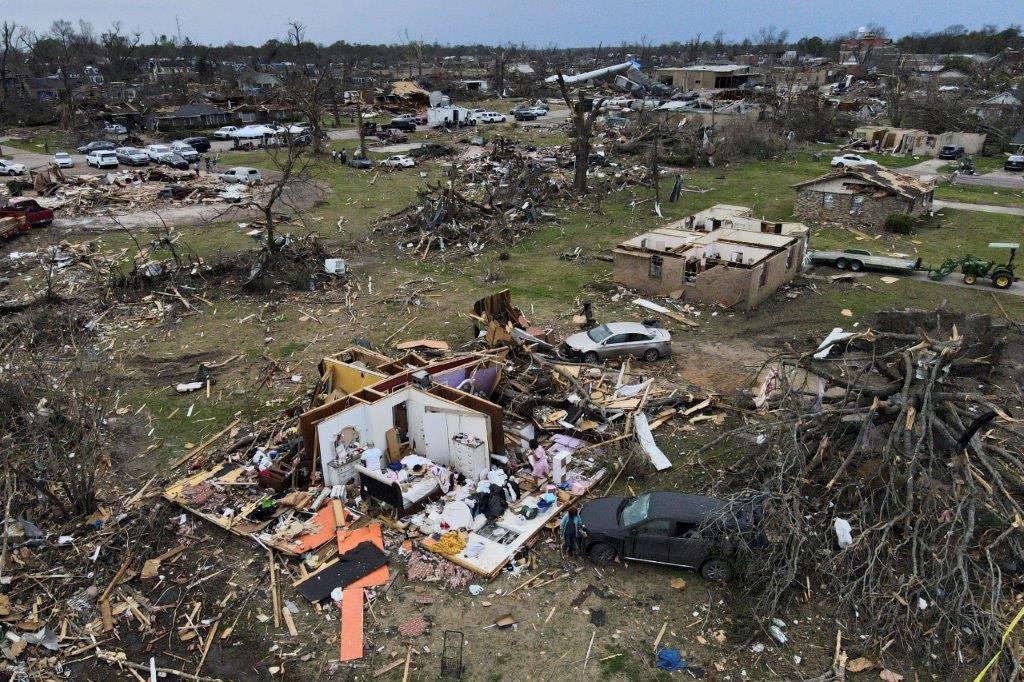
Deadly Tornadoes Strike Texas and Mississippi, Severe Storms Continue Across the U.S.
At least two people have died as powerful storms and tornadoes ripped through Texas and Mississippi on Saturday, while a series of atmospheric river-driven storms lashed the western United States.
In northern Brazoria County, Texas, one person was killed, and four others sustained non-critical injuries, according to the county sheriff’s office. The area, located about 45 miles south of Houston, continues to undergo search and recovery efforts. “We don’t expect additional fatalities at this time,” said spokesperson Madison Polston.
In Natchez, Mississippi, a high school student lost their life when a tree fell on a home, said Adams County Emergency Management spokesperson Neifa Hardy. Another two people were injured, and one home was destroyed. “The devastation is significant in certain areas,” added Malary White of the Mississippi Emergency Management Agency.
Tornado Watches Affect Millions
Nearly 7 million Americans are under tornado watches, including over 2 million in Arkansas, Louisiana, Mississippi, and Texas. The National Weather Service (NWS) has issued a rare “particularly dangerous situation” watch, warning of strong tornadoes and widespread damage. These conditions could produce multiple EF2 or stronger tornadoes.
A tornado was reported near Cleveland, Texas, and another near Katy, just outside Houston. The Storm Prediction Center elevated the tornado risk to a level 4 of 5 for central Louisiana, Mississippi, and western Alabama, warning of damaging winds, hail, and long-track tornadoes.
Destruction and Survival Stories
In Katy, Texas, Omar Godoy experienced a tornado firsthand while watching the movie Twister. He and his nephew took cover in a closet as their home shook. “It was only three minutes, but it felt terrifying,” Godoy said, noting this was the third tornado in their neighborhood this year.
In Porter, Texas, Katt Lomison described her subdivision’s devastation. “Trees were down, sheds flattened, and one house is completely gone,” she said. Drone footage revealed severe structural damage throughout the area.
In Brazoria County, Manvel Mayor Daniel Davis reported widespread destruction, including damaged homes, schools, and businesses. Sheriff Bo Stallman emphasized the challenges of preparing for fast-developing tornadoes: “They form so quickly, leaving little time to take shelter.”
The Threat Shifts Eastward
The storm system is moving east, threatening areas from Georgia to Virginia with potential tornadoes and damaging winds on Sunday. Cities like Atlanta, Charlotte, and Raleigh are bracing for severe weather. Meanwhile, minor travel delays are expected along the East Coast.
West Coast Faces Atmospheric River Storms
In the western U.S., atmospheric river-fueled storms are delivering heavy rain, strong winds, and mountain snow. Coastal California faces waves up to 30 feet, creating dangerous conditions for swimmers and surfers. High winds exceeding 75 mph are also expected in the Pacific Northwest and Rockies, raising the risk of power outages and travel disruptions.
Winter weather alerts remain in effect for the Cascades, Sierra Nevada, and Rockies, where snowfall could reach 18 inches or more. Avalanche warnings have been issued for parts of northern Utah, including the Wasatch and Bear River ranges.
These severe storms mark a stark contrast to typical December tornado activity, which averages about 40 occurrences nationwide. This year, however, has already seen 1,783 tornado reports, far surpassing the yearly average of 1,347. Widespread power outages are expected,” warns the weather service. “Travel will be difficult, especially for high profile vehicles, including areas along Highway 395 and Highway 95 near Walker Lake.
As the nation grapples with widespread severe weather, residents are urged to stay alert and heed warnings for their areas. High winds are expected to continue to blow across parts of the Pacific Northwest and the Rockies, where high wind alerts are in place. Winds gusting over 75 mph are possible, which could topple trees and power lines.